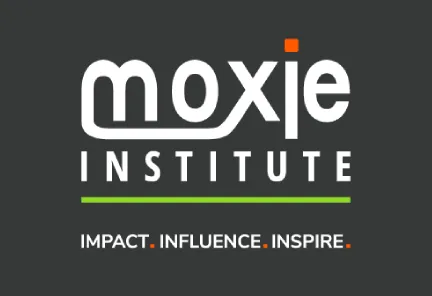In today’s rapidly evolving business landscape, effective leadership has never been more crucial. Yet a concerning disconnect exists in many organizations: while 90% of executives believe their company’s mission and values are clearly communicated, only 61% of employees agree, according to research from Gallup. This gap represents more than just a communication breakdown—it signals that leaders may not be effectively embodying and conveying the very mission they’re tasked with representing. When leaders fail to authentically represent an organization’s mission, the ripple effects can be profound, impacting everything from employee engagement and retention to customer loyalty and bottom-line results.
At Moxie Institute, we’ve witnessed firsthand how transformational it can be when leaders truly embody their organization’s mission. Through our work with Fortune 500 executives and emerging leaders across industries, we’ve seen how leadership presence becomes a powerful catalyst for organizational alignment, employee motivation, and authentic brand representation. But what exactly does it mean for leaders to effectively represent a mission, and how can organizations ensure their leadership team is equipped to do so?
This comprehensive guide explores how leaders can authentically embody and communicate your organization’s mission, providing actionable strategies grounded in neuroscience, performance psychology, and communication expertise. Whether you’re looking to strengthen your own leadership presence or develop more mission-aligned leaders across your organization, these insights will help transform how your mission comes to life through leadership.
The Mission-Leadership Connection
Why Leaders Are Mission Personified
Your organization’s mission isn’t just words on a wall or website—it’s the living, breathing purpose that should drive every decision, interaction, and initiative. Leaders serve as the primary conduits through which this mission flows into daily operations and culture. According to research published in the Journal of Business Ethics, employees look to their leaders’ behaviors—not corporate statements—to understand what truly matters in an organization.
When leaders authentically embody your mission, they transform abstract concepts into tangible realities. They become walking manifestations of your organization’s purpose, bringing clarity and consistency to workplace culture. This alignment creates what psychologists call “cognitive coherence”—a state where what people hear matches what they see, reducing psychological friction and building trust.
“Leaders don’t just communicate the mission—they personify it through their actions, decisions, and presence,” explains Dr. Amy Edmondson of Harvard Business School in her research on psychological safety. “When this alignment exists, it creates a powerful sense of organizational integrity that employees and customers instantly recognize.”
This embodiment matters because humans are wired to detect inconsistencies between stated values and actual behaviors. Our brains process these disconnects as potential threats, triggering skepticism and disengagement. Conversely, when leaders authentically represent the mission, it activates reward centers in the brain associated with trust and belonging, fostering deeper engagement and commitment.
Quick Takeaways:
- Leaders serve as the living embodiment of your organization’s mission and values
- Employees look to leadership behavior, not statements, to interpret organizational priorities
- Authentic mission alignment creates cognitive coherence that builds trust and engagement
- The human brain is specifically attuned to detect inconsistencies between stated values and observed behaviors
The Costly Impact of Mission Misalignment
When leaders fail to effectively represent your mission, the consequences extend far beyond mere inconsistency. Research from Gallup shows that organizations with poor mission alignment among leadership experience 30% higher turnover rates and 23% lower productivity compared to those with strong alignment.
These statistics represent real organizational costs. At Moxie Institute, we’ve observed that mission misalignment typically manifests in three critical business impacts:
- Eroded Employee Trust and Engagement: When employees observe leaders whose actions contradict the organization’s stated mission, it creates cognitive dissonance and undermines psychological safety. A study published in the Journal of Applied Psychology found that perceived leadership hypocrisy is the single strongest predictor of employee cynicism, which directly correlates with lower engagement and higher absenteeism.
- Diluted Brand Identity: Leaders are brand ambassadors whether they recognize it or not. When their behaviors don’t align with your mission, it creates confusion about what your organization truly stands for. This inconsistency weakens your competitive differentiation and market positioning.
- Strategic Misalignment: Perhaps most costly is how mission-disconnected leadership leads to scattered priorities and initiatives that don’t serve your core purpose. McKinsey research shows that organizations with leadership teams misaligned on purpose waste up to 30% of their strategic resources on initiatives that don’t advance their central mission.
The financial implications are significant. A 2023 study from the Corporate Executive Board found that companies with strong mission alignment at leadership levels outperformed their sectors by 16% in profitability. Meanwhile, those with poor alignment underperformed by 7.5%.
Executive Insight: “Having led transformation initiatives across multiple Fortune 500 companies, I’ve seen firsthand that any significant change effort will fail unless the leadership team truly embodies the mission driving that change,” notes one senior executive we worked with at Moxie Institute. “You simply cannot delegate mission representation—it must live in the behaviors of every leader.”
Recognizing Mission Alignment Gaps
Signs Your Leaders Aren’t Embodying Your Mission
Identifying mission misalignment isn’t always straightforward, as it often appears gradually and manifests in subtle ways before becoming obvious problems. Based on our work with thousands of organizations, these warning signs consistently indicate that leaders may not be effectively representing your mission:
- Disconnected Decision Patterns: Leaders make decisions that prioritize short-term gains over long-term mission fulfillment, or they consistently fail to reference mission and values when explaining strategic choices.
- Storytelling Deficiency: When asked about organizational purpose, leaders struggle to articulate compelling stories that connect daily work to the broader mission, relying instead on generic corporate language.
- Selective Value Application: Leaders emphasize certain aspects of the mission when convenient but ignore others that might require more difficult changes or commitment.
- Communication Inconsistency: Different leaders describe the organization’s purpose and priorities in contradictory ways, creating confusion about what truly matters.
- Resource Misalignment: Time, budget, and attention are allocated to initiatives with unclear connections to stated mission and values.
- “Us vs. Them” Mentality: Leaders refer to the mission as something the organization or “higher-ups” care about rather than speaking from personal conviction.
- Values-Behavior Gap: A noticeable disconnect exists between the behaviors a leader recognizes in others (through rewards, promotions, or praise) and the organization’s stated values.
- Mission Fatigue: Leaders show diminishing enthusiasm when discussing organizational purpose, treating mission conversations as obligatory rather than energizing.
Expert Perspective: “In our assessment work with executive teams, we find that mission misalignment often begins with small inconsistencies that gradually expand,” explains a senior leadership development expert from Moxie Institute. “For example, a leader might occasionally prioritize short-term metrics over mission-aligned behaviors. When this goes unaddressed, it becomes a pattern that others interpret as the ‘real priorities,’ regardless of what’s in the mission statement.”
Leadership Reflection Exercise:
Consider how consistently your leadership team demonstrates these mission-aligned behaviors:
- Referencing your mission when making difficult decisions
- Telling stories that connect daily work to your broader purpose
- Allocating time and resources to initiatives that directly advance your mission
- Recognizing and rewarding behaviors that exemplify your values
- Speaking about your mission with personal conviction and enthusiasm
If these behaviors aren’t consistently present across your leadership team, you likely have mission alignment gaps that need addressing.
Conducting a Leadership-Mission Alignment Assessment
To move beyond anecdotal evidence and gain actionable insights about your leadership team’s mission alignment, a structured assessment approach is essential. Here’s a proven methodology we’ve implemented with clients across industries:
Step 1: Establish Clear Mission Manifestations
Start by clearly defining how your mission should manifest in observable leadership behaviors. Work with your executive team to answer: “If our leaders were perfectly embodying our mission, what specific behaviors would we see consistently?”
For example, if your mission emphasizes customer-centricity, corresponding behaviors might include:
- Regularly spending time directly engaging with customers
- Starting meetings with customer stories or perspectives
- Evaluating decisions based on customer impact
- Prioritizing customer experience investments even when they affect short-term financials
Step 2: Implement Multi-Source Feedback
Gather data from multiple perspectives using these complementary approaches:
- 360-Degree Mission Assessment: Adapt traditional 360 feedback to focus specifically on mission-aligned behaviors. Include questions like “How consistently does this leader reference our mission when making difficult decisions?” or “To what extent does this leader’s behavior exemplify our value of [specific value]?”
- Mission-Specific Interviews: Conduct structured interviews with key stakeholders to gather qualitative insights about how leaders represent the mission. Include questions about when leaders have most powerfully embodied the mission and where disconnects might exist.
- Observational Analysis: Have trained observers attend key meetings and interactions, specifically noting mission-relevant behaviors, language patterns, and decision frameworks.
Step 3: Analyze Alignment Patterns
Look for patterns in the data that reveal:
- Which aspects of your mission are most consistently represented by leaders
- Where the most significant gaps exist between stated mission and leadership behavior
- Whether misalignment is organization-wide or concentrated in specific departments or leadership levels
- How alignment compares between formal communications and day-to-day behaviors
Step 4: Create Individual and Collective Feedback Loops
Develop feedback mechanisms that help leaders understand their current mission alignment and specific opportunities for improvement:
- Individual feedback sessions that highlight personal strengths and gaps
- Team-level discussions about collective patterns and improvement opportunities
- Organization-wide transparency about leadership alignment with anonymized data
Pro Tip: “The most valuable mission alignment assessments create a safe space for honest feedback,” notes an executive communication coach from Moxie Institute. “We’ve found that prefacing these assessments with explicit statements that they’re for growth, not evaluation, dramatically increases the quality and honesty of the feedback provided.”
The Neuroscience of Mission-Aligned Leadership

How the Brain Processes Authenticity
Understanding the neuroscience behind how people perceive leader authenticity provides valuable insights into why mission alignment matters at a biological level. Research in cognitive neuroscience reveals that our brains are remarkably adept at detecting incongruence between words and actions.
When we observe leaders whose behaviors contradict stated values or organizational mission, the brain’s conflict detection centers—particularly the anterior cingulate cortex—become activated. This activation triggers a cascade of neurological responses:
- Trust Inhibition: Inconsistency activates the amygdala, which processes potential threats and reduces oxytocin production—the neurochemical essential for trust formation.
- Cognitive Strain: The brain must work harder to reconcile the contradiction between what’s said and what’s observed, depleting cognitive resources that could otherwise be directed toward productive work.
- Emotional Contagion Disruption: Mirror neurons, which help us connect emotionally with others, function less effectively when we perceive inauthenticity, reducing emotional engagement with leaders and their messages.
Conversely, when leaders authentically embody the mission, different neurological pathways activate:
- Trust Enhancement: Consistent alignment between words and actions increases oxytocin production, strengthening social bonds and trust.
- Cognitive Fluency: Consistency creates cognitive ease—the brain doesn’t have to work to reconcile contradictions, making the leader’s message more persuasive and easier to process.
- Motivational Activation: Authentic mission alignment activates the brain’s reward circuitry, particularly the ventral striatum, enhancing motivation and commitment.
According to research from the NeuroLeadership Institute, this neurological response to authenticity explains why employees are up to four times more engaged when they perceive leaders as genuinely embodying organizational values rather than merely talking about them.
Research Insight: “Our neuroimaging studies show that within milliseconds, the brain distinguishes between authentic and inauthentic emotional expressions,” explains Dr. Richard Boyatzis, professor at Case Western Reserve University. “This same rapid detection applies to leadership behaviors that either align with or contradict stated values and mission.”
Building Neural Pathways for Mission Embodiment
For leaders seeking to authentically represent your mission, understanding how to build the neural pathways that support consistent mission alignment is critical. This isn’t just about learning what to say—it requires creating new patterns of thinking and behaving that eventually become automatic.
The Neuroscience of Habit Formation in Leadership
Research in neuroplasticity—the brain’s ability to reorganize itself by forming new neural connections—shows that mission-aligned leadership can be systematically developed through deliberate practice:
- Repetition Creates Neural Strength: When leaders consistently make decisions with explicit reference to the mission, they strengthen neural pathways that make this connection automatic over time. Research published in the Journal of Neurophysiology suggests that it takes approximately 30-60 days of consistent practice for new neural pathways to stabilize.
- Emotional Tagging Enhances Retention: When mission connections are paired with positive emotional experiences, the brain’s hippocampus (critical for memory formation) encodes these connections more strongly. This explains why leaders who find personal meaning in the mission represent it more effectively.
- Implementation Intentions Overcome Default Patterns: The prefrontal cortex, responsible for executive function, can be programmed with specific “if-then” plans that help leaders respond to situations in mission-aligned ways, even when under pressure.
Practical Application: The Mission Integration Protocol
Based on these neurological principles, we’ve developed a protocol to help leaders strengthen their mission embodiment:
- Morning Mission Priming: Begin each day by reviewing how specific elements of your schedule connect to the organization’s mission. This activates relevant neural pathways before decision-making situations arise.
- Decision Point Pausing: Introduce a brief pause before significant decisions specifically to consider: “How does this choice reflect our mission?” This strengthens the neural connection between decision-making centers and mission awareness.
- Narrative Reinforcement: Regularly articulate stories that connect work accomplishments to mission fulfillment. This creates stronger emotional associations that reinforce mission-aligned neural pathways.
- Implementation Planning: Create specific plans for how you’ll handle challenging situations while staying aligned with your mission. For example: “When faced with pressure to compromise quality for speed, I will explicitly reference our commitment to excellence.”
- Reflection Cycles: End each week with structured reflection on when mission alignment was strongest and where it could have been improved. This metacognitive practice accelerates neural pathway formation.
Expert Insight: “Leaders often assume mission alignment should come naturally if they believe in the mission,” notes a performance psychologist who works with Moxie Institute. “But from a neurological perspective, it’s no different than developing any complex skill—it requires deliberate practice, feedback, and progressive reinforcement of new neural pathways.”
Core Components of Mission-Aligned Leadership
Authentic Communication
Effective mission representation begins with how leaders communicate about organizational purpose. Authentic communication transcends merely repeating mission statements—it involves bringing the mission to life through personalized, meaningful expression.
The Three Dimensions of Mission-Aligned Communication
Based on our work with thousands of leaders, three distinct dimensions of communication must be aligned for leaders to effectively represent your mission:
- Conceptual Clarity: Leaders must be able to articulate what the mission means in clear, concise, and compelling terms. This requires moving beyond corporate jargon to express purpose in language that resonates emotionally and intellectually.
- Personal Connection: Authentic communication demonstrates the leader’s personal relationship with the mission. This includes sharing why the mission matters to them personally and how it influences their own choices and behaviors.
- Contextual Relevance: Leaders must translate the broad mission into specific meaning for different teams, roles, and situations. This means helping people understand how their daily work contributes to the larger purpose.
Research from Harvard Business Review found that leaders skilled in all three dimensions generate 55% higher team performance compared to those who only master conceptual clarity without personal connection or contextual relevance.
Building Your Mission Communication Toolkit
To strengthen authentic mission communication, develop these essential tools:
- Your Mission Origin Story: A brief, compelling narrative about how you personally connected with the organization’s mission and why it matters to you.
- Mission-to-Action Translations: Specific examples that illustrate how abstract mission concepts manifest in concrete decisions and behaviors.
- Team Relevance Maps: Clear articulations of how each team member’s role contributes to mission fulfillment, tailored to individual strengths and responsibilities.
- Mission Decision Frameworks: Explicit criteria for how the mission influences decision-making in different contexts, making values-based reasoning transparent.
Try It Yourself: The Personal Mission Connection Exercise
To strengthen your authentic communication about your organization’s mission:
- Write down your organization’s mission statement.
- Reflect on a specific moment when you personally experienced the impact or importance of this mission. What happened? How did it affect you?
- Identify three specific ways this mission has influenced your own leadership decisions in the past month.
- Practice articulating a 60-second response to: “Why does this mission matter to you personally?”
- Ask a trusted colleague for feedback on how authentically you communicate about the mission.
This exercise strengthens the neural connections between your personal experiences and the organizational mission, making your communication more authentic and compelling.
Value-Based Decision Making
How leaders make decisions represents one of the most visible ways they either reinforce or undermine your organizational mission. Value-based decision making creates alignment between stated purpose and actual behavior by explicitly using mission and values as decision criteria.
The Decision Alignment Framework
In our work with executive coaching clients, we’ve developed a structured approach to value-based decision making that ensures mission alignment:
- Explicit Value Identification: Before evaluating options, clearly identify which organizational values and mission elements are relevant to the decision at hand.
- Option-Value Mapping: For each potential decision option, assess how well it aligns with each relevant value, creating a “mission alignment score.”
- Trade-Off Transparency: When values appear to conflict (such as innovation vs. stability), make the reasoning process visible, showing how you’re prioritizing different aspects of the mission.
- Decision Communication: When announcing decisions, explicitly connect the choice to mission fulfillment, reinforcing the role of values in the decision-making process.
Research from McKinsey & Company shows that organizations using structured value-based decision frameworks demonstrate 22% greater strategic alignment across leadership teams and significantly higher employee trust in leadership.
Real-World Application
Consider how different decisions might be approached through a value-based lens:
Scenario: A potential cost-cutting initiative would improve short-term financials but might impact customer experience.
Traditional Approach: Evaluate based primarily on financial impact, with customer experience as a secondary consideration.
Value-Based Approach: If customer-centricity is a core value in your mission, begin by assessing the customer impact, then determine if the financial benefit justifies any potential compromise to the customer experience.
The difference might seem subtle, but it fundamentally changes what factors receive priority in the decision process. Over time, these priorities become visible to everyone in the organization, either reinforcing or undermining your stated mission.
Expert Insight: “The most mission-aligned leaders we work with have internalized their organization’s values so deeply that they automatically filter decisions through this lens,” explains a leadership development specialist from Moxie Institute. “But this doesn’t happen by accident—it requires deliberate practice in making the connection between values and decisions explicit.”
Consistent Behavioral Modeling
Beyond what leaders say and how they make decisions, their day-to-day behaviors serve as powerful demonstrations of what truly matters in your organization. Behavioral modeling involves consistently demonstrating the behaviors that embody your mission and values, even when under pressure or when no one seems to be watching.
The Behavioral Consistency Challenge
Research from the Center for Creative Leadership reveals that 65% of employees report regularly observing leaders acting in ways that contradict stated organizational values. This behavioral inconsistency creates what psychologists call an “integrity gap” that undermines trust and engagement.
The most common scenarios where leaders’ behaviors drift from mission alignment include:
- Under Pressure: When facing tight deadlines, financial constraints, or crisis situations
- In Private Settings: How leaders behave in smaller meetings versus public forums
- Regarding Status: How leaders treat people at different organizational levels
- With Resources: How leaders allocate their own time, attention, and organizational resources
- Through Rewards: What behaviors leaders recognize, promote, and celebrate
Building Behavioral Congruence
To strengthen behavioral modeling of your mission:
- Identify Mission-Critical Behaviors: Define 3-5 specific, observable behaviors that most powerfully demonstrate each core value in your mission.
- Create Behavioral Commitments: Have leaders explicitly commit to these behaviors, sharing these commitments with their teams to create accountability.
- Implement Peer Observation: Establish a practice where leadership team members observe and provide feedback to each other specifically on mission-aligned behaviors.
- Develop Pressure-Testing Scenarios: Use simulations and role-plays to practice maintaining mission alignment during challenging situations.
- Install Behavioral Nudges: Create environmental cues and reminders that prompt mission-aligned behaviors at decision points.
Leadership Story: “One organization we worked with had ‘respect for all stakeholders’ as a core value, but in leadership meetings, certain executives regularly interrupted and dismissed ideas from newer team members,” shares a Moxie Institute coach. “We implemented a simple intervention—a small bell that anyone could ring when someone was interrupted. This physical reminder dramatically changed meeting behavior within weeks and eventually transformed the broader culture of communication.”
Quick Takeaways:
- Leaders’ everyday behaviors speak louder than formal mission statements in shaping culture
- Behavioral consistency is most tested during high-pressure situations and private interactions
- Specific, observable behaviors should be identified for each core value
- Peer observation and feedback accelerate behavioral alignment with mission
- Environmental cues and reminders help maintain behavioral consistency
Emotional Intelligence and Mission Connection
The ability to connect emotionally with your organization’s mission—and help others do the same—represents a critical dimension of mission-aligned leadership. Emotional intelligence (EI) serves as the foundation for this connection, enabling leaders to recognize, understand, and effectively engage with the emotional aspects of purpose-driven work.
The Emotional Dimensions of Mission
Research from the Yale Center for Emotional Intelligence demonstrates that organizational missions operate on both rational and emotional levels:
- Rational Dimension: The logical case for why the mission matters and how it creates value
- Emotional Dimension: The feelings the mission evokes and how it connects to deeper human needs and aspirations
Leaders with high emotional intelligence excel at bridging these dimensions, helping people connect intellectually AND emotionally with the organizational purpose. This emotional connection is crucial—studies show that emotional engagement with a mission is 2.5 times more predictive of discretionary effort than rational understanding alone.
Four EI Components for Mission Alignment
To strengthen the emotional aspects of mission representation, leaders should develop these four components of emotional intelligence:
- Self-Awareness: Recognizing your own emotional connection to the mission, including what aspects energize you and which might feel less personally meaningful.
- Self-Regulation: Managing your emotional expression to consistently represent mission enthusiasm, even during challenging periods, without appearing inauthentic.
- Social Awareness: Recognizing how different team members emotionally connect with various aspects of the mission and what barriers might exist to their emotional engagement.
- Relationship Management: Helping others strengthen their emotional connection to the mission through personalized approaches that resonate with their values and aspirations.
Applied EI in Mission Communication
Leaders with high emotional intelligence adapt their mission communication based on emotional cues from their audience. For example:
- When they sense skepticism, they acknowledge concerns before sharing their own conviction
- When they observe enthusiasm, they create space for others to express their connection
- When they detect confusion, they translate abstract mission concepts into concrete examples
- When they perceive disconnection, they find personalized ways to make the mission relevant
Development Strategy: “We’ve found that executive presence and emotional intelligence are intimately connected,” explains a Moxie Institute facilitator. “Leaders who develop the ability to be fully present—listening deeply, observing emotional cues, and responding authentically—dramatically improve their capacity to help others connect emotionally with the organizational mission.”
Common Roadblocks to Mission Alignment

Addressing Misalignment Challenges
Even with the best intentions, leaders often encounter specific challenges that create disconnects between organizational mission and leadership behavior. Recognizing and addressing these common roadblocks is essential for strengthening mission alignment.
Primary Mission Alignment Obstacles
Based on our work with thousands of leaders across industries, these represent the most common barriers to effective mission representation:
- Mission Abstraction: When organizational missions are expressed in vague, generic terms, leaders struggle to translate them into specific behaviors and decisions. This abstraction creates a natural disconnect between high-level purpose and day-to-day leadership.
- Competing Priorities: Leaders frequently face tensions between short-term performance demands and longer-term mission fulfillment. Without clear frameworks for navigating these tensions, immediate pressures often override mission considerations.
- Incentive Misalignment: When reward systems (compensation, recognition, promotion) don’t explicitly value mission-aligned behaviors, leaders receive mixed messages about what truly matters, especially when financial incentives conflict with stated values.
- Skill Gaps: Many leaders intellectually understand the mission but lack specific skills required to effectively embody or communicate it—particularly storytelling, authentic communication, and emotional intelligence capabilities.
- Cultural Legacy: Established organizational habits, norms, and “unwritten rules” can undermine new mission aspirations, particularly when these cultural elements developed under different leadership or strategic priorities.
Strategic Solutions for Common Roadblocks
For each of these obstacles, specific interventions can help leaders overcome mission alignment challenges:
For Mission Abstraction:
- Create a “mission translation guide” that explicitly connects abstract mission language to concrete behaviors and decisions
- Develop mission-specific scenarios that illustrate how values apply in common leadership situations
- Implement regular mission reflection sessions where leaders share specific examples of mission fulfillment
For Competing Priorities:
- Establish clear decision hierarchies that explicitly place mission-critical values in priority order
- Create “mission impact assessments” for major decisions that might create tension between short-term gains and mission alignment
- Develop peer coaching protocols specifically for navigating competing priorities while maintaining mission integrity
For Incentive Misalignment:
- Audit formal and informal reward systems to identify disconnects with stated mission and values
- Implement specific recognition programs that celebrate mission-aligned leadership behaviors
- Modify performance evaluation criteria to explicitly include mission representation metrics
For Skill Gaps:
- Provide targeted leadership and communication training in storytelling, authentic communication, and emotional intelligence
- Create mentoring pairs that connect leaders skilled in mission embodiment with those seeking to improve
- Implement “mission message labs” where leaders practice articulating mission connections and receive expert feedback
For Cultural Legacy:
- Conduct cultural assessment to identify specific norms that support or undermine mission alignment
- Create explicit “from/to” statements that describe the cultural shift required for mission fulfillment
- Identify and engage informal cultural influencers who can help reshape legacy norms
Leadership Reflection: “One of the most powerful questions we ask executive teams is: ‘What behaviors are you currently rewarding that might actually undermine your stated mission?'” shares a Moxie Institute consultant. “This single question often reveals profound disconnects between what organizations say they value and what their systems actually reinforce.”
Overcoming Implementation Obstacles
Beyond identifying theoretical solutions, leaders must navigate real-world implementation challenges when strengthening mission alignment. These practical obstacles often determine whether good intentions translate into meaningful change.
Common Implementation Barriers
Based on our experience guiding mission alignment initiatives, these practical challenges most frequently derail implementation efforts:
- Attention Dilution: Mission alignment initiatives compete with numerous other organizational priorities for leadership time and focus, often getting deprioritized amid daily operational demands.
- Measurement Difficulties: Unlike financial metrics, mission alignment can be challenging to measure objectively, making progress harder to track and celebrate.
- Psychological Resistance: Leaders may experience discomfort when asked to examine potential misalignment between their behaviors and organizational values, triggering defensive responses.
- Cascading Consistency: Ensuring mission alignment extends beyond senior leadership to middle management often proves particularly challenging, as these leaders face intense operational pressures.
- Sustaining Momentum: Initial enthusiasm for mission alignment frequently diminishes over time without structured reinforcement systems.
Practical Implementation Strategies
For each implementation barrier, specific strategies can help organizations maintain momentum:
For Attention Dilution:
- Integrate mission alignment into existing leadership routines rather than creating separate initiatives
- Schedule regular but brief “mission moments” in standing meetings to maintain focus without requiring additional time
- Create visual reminders of mission priorities in physical and digital workspaces to maintain awareness
For Measurement Difficulties:
- Develop both qualitative and quantitative metrics specifically for mission alignment
- Implement pulse surveys that regularly assess employee perceptions of leadership mission alignment
- Create mission alignment dashboards that visualize progress across multiple dimensions
For Psychological Resistance:
- Frame mission alignment as a collective growth journey rather than an evaluation process
- Create psychological safety by having senior leaders openly discuss their own alignment challenges
- Use skilled facilitators for sensitive feedback discussions about alignment gaps
For Cascading Consistency:
- Provide middle managers with simplified tools to integrate mission alignment into their daily leadership
- Create peer learning communities where managers share practical mission alignment tactics
- Recognize and celebrate specific examples of mission-aligned leadership at all organizational levels
For Sustaining Momentum:
- Establish quarterly mission alignment review sessions to refresh commitment and share progress
- Create a dedicated “mission alignment team” with rotating membership to maintain ongoing focus
- Integrate mission alignment metrics into regular business reviews alongside operational measures
Implementation Insight: “The organizations that most successfully implement mission alignment don’t treat it as a separate initiative,” notes a Moxie Institute executive coach. “Instead, they weave it into the fabric of how they already operate—their meeting structures, their decision processes, their recognition systems, and their daily leadership routines. This integration approach dramatically increases sustainability.”
Developing Mission-Aligned Leaders
Training Strategies That Work
Developing leaders who effectively represent your mission requires intentional, well-designed training approaches. Based on adult learning theory and our experience with thousands of leaders, these strategies consistently produce meaningful improvements in mission alignment:
Experiential Learning for Mission Embodiment
Traditional mission training often relies heavily on conceptual understanding, which rarely translates to behavior change. Instead, effective mission alignment training emphasizes experiential learning that creates both intellectual and emotional connections:
- Mission-Critical Scenarios: Immersive simulations where leaders practice navigating challenging situations while maintaining mission alignment. These scenarios should reflect real-world tensions that test mission commitment.
- Values-Based Decision Laboratories: Structured exercises where leaders apply mission criteria to complex decisions, receiving immediate feedback on alignment from peers and facilitators.
- Mission Storytelling Workshops: Interactive sessions where leaders develop, practice, and refine personal stories that connect organizational purpose to their own values and experiences.
- Behavioral Modeling Observation: Structured opportunities to observe exemplary mission-aligned leaders in action, followed by guided reflection on specific behaviors that demonstrate mission embodiment.
- Stakeholder Perspective Immersions: Experiences that place leaders directly in the position of key stakeholders (customers, employees, community members) to develop deeper emotional understanding of mission impact.
Research-Backed Training Design Principles
To maximize learning transfer, mission alignment training should incorporate these evidence-based design elements:
- Spaced Learning: Breaking training into multiple shorter sessions spaced over time rather than single intensive events
- Deliberate Practice: Providing multiple opportunities to practice specific mission-aligned behaviors with expert feedback
- Social Learning: Creating peer coaching relationships that maintain focus on mission alignment between formal training
- Contextual Application: Requiring immediate application of concepts to leaders’ actual work situations
- Metacognitive Reflection: Guiding leaders to reflect on their own mission alignment learning process
Training Customization Factors
Effective mission training must be tailored to organizational context and leadership needs:
- Mission Maturity: The degree to which mission is already integrated into organizational processes
- Leadership Level: Different approaches for executives, middle managers, and emerging leaders
- Industry Context: How mission manifests differently across various sectors and business models
- Organizational Culture: Adapting approaches to work within existing cultural norms while driving positive change
- Strategic Priorities: Aligning mission training with current business challenges and opportunities
Expert Insight: “The most effective mission alignment training directly addresses the ‘last mile problem’ in leadership development,” explains a Moxie Institute senior facilitator. “It’s not enough to understand the mission intellectually or even feel committed to it emotionally. Leaders need practical tools to translate that understanding and commitment into consistent behaviors, especially when facing conflicting priorities or high-pressure situations.”
Coaching for Mission Embodiment
While training provides essential skills and awareness, personalized coaching creates the sustained focus and accountability necessary for lasting behavior change. Executive coaching specifically designed for mission alignment helps leaders integrate organizational purpose into their authentic leadership style.
The Mission Alignment Coaching Model
Based on our work with hundreds of executive coaching clients, we’ve developed a specialized approach for mission embodiment coaching:
- Mission Personality Assessment: Identifying how the leader’s natural strengths, values, and communication style can authentically express the organization’s mission.
- Alignment Gap Analysis: Gathering feedback from key stakeholders about specific behaviors that either reinforce or undermine mission alignment.
- Personal Mission Translation: Developing the leader’s personalized understanding of how each mission element manifests in their specific role and responsibilities.
- Behavioral Goal Setting: Establishing concrete, observable behavior changes that will strengthen mission alignment.
- Implementation Support: Providing real-time coaching during key meetings, presentations, and decision processes to reinforce mission-aligned behaviors.
- Reflection and Refinement: Creating structured opportunities to review progress, adjust approaches, and deepen mission integration.
Coaching Techniques for Mission Alignment
Effective mission alignment coaches employ specialized techniques to help leaders internalize the organization’s purpose:
- Values Clarification: Exploring the intersection between personal values and organizational mission to identify authentic connection points.
- Cognitive Reframing: Helping leaders recognize and shift thought patterns that create disconnects between personal priorities and organizational purpose.
- Deliberate Practice Design: Creating customized practice opportunities for mission-critical communication and decision scenarios.
- Shadow Coaching: Observing leaders in real work situations to provide immediate feedback on mission alignment.
- Narrative Development: Supporting leaders in crafting and refining personal stories that connect their leadership journey to the organizational mission.
Mission-Aligned Leadership Success Story:
“We worked with the CEO of a healthcare organization who intellectually understood their mission of ‘patient-centered care’ but struggled to demonstrate it consistently in leadership behaviors,” shares a Moxie Institute executive coach. “Through our coaching process, we discovered that her financial background made her naturally focus on efficiency metrics rather than patient experience.
“We developed customized practices including weekly patient story sessions and ‘mission impact’ questions for her executive team meetings. Within three months, her leadership team reported a dramatic shift in how consistently she represented the patient-centered mission, and employee engagement scores showed significant improvement in perceptions of mission alignment at the senior level.”
Creating Accountability Systems
For mission alignment to move beyond good intentions, organizations need structured accountability systems that maintain focus and provide ongoing feedback. These systems ensure that mission representation becomes a consistent priority rather than a periodic consideration.
Structured Accountability Frameworks
Organizations with strong mission alignment typically implement multiple, reinforcing accountability mechanisms:
- Mission Alignment Reviews: Regular (quarterly or monthly) structured discussions specifically focused on how leadership behaviors and decisions have advanced the mission.
- Peer Accountability Partnerships: Paired relationships between leaders who provide regular feedback to each other specifically on mission alignment.
- Stakeholder Feedback Channels: Systematic collection of input from employees, customers, and other stakeholders about leadership mission alignment.
- Mission Metrics Dashboard: Visual tracking of specific, measurable indicators of mission-aligned leadership behaviors and outcomes.
- Values-Based Recognition Systems: Formal programs that identify, celebrate, and reward exemplary mission representation.
Implementing Effective Feedback Loops
The quality of feedback significantly impacts mission alignment progress. Effective feedback systems share these characteristics:
- Specificity: Focusing on concrete behaviors rather than general impressions
- Balanced Perspective: Identifying both positive alignment and improvement opportunities
- Psychological Safety: Creating environments where candid feedback is welcomed and appreciated
- Forward Orientation: Emphasizing future improvement rather than past criticism
- Regular Cadence: Providing consistent, predictable feedback opportunities
Leadership Board Impact: “One particularly effective approach we’ve implemented is the creation of ‘Mission Advisory Boards’ composed of diverse stakeholders from different organizational levels,” notes a leadership development specialist from Moxie Institute. “These boards meet quarterly with senior leaders to provide direct feedback on mission alignment. The unique power of these boards comes from including voices that leaders might not typically hear from, creating powerful accountability that transcends traditional hierarchies.”
Practical Application: The Mission Alignment Scorecard
A structured scorecard provides consistent measurement of leadership mission alignment. It typically includes:
- Behavioral Indicators: Observable leadership actions that demonstrate mission alignment
- Decision Alignment: Assessment of how major decisions reflected mission priorities
- Communication Consistency: Evaluation of how messaging reinforced mission elements
- Resource Allocation: Analysis of how time, attention, and budget aligned with mission
- Stakeholder Perceptions: Feedback from key groups about leadership mission representation
These scorecard components can be assessed through self-evaluation, peer feedback, stakeholder surveys, and objective metrics, creating a comprehensive picture of mission alignment progress.
Quick Takeaways:
- Sustainable mission alignment requires structured accountability systems
- Effective accountability combines multiple, reinforcing mechanisms
- Quality feedback should be specific, balanced, psychologically safe, and forward-oriented
- Mission Advisory Boards with diverse stakeholders create powerful accountability
- Structured scorecards provide consistent measurement of leadership mission alignment
Measuring Mission Alignment Success
Key Performance Indicators
Effective measurement of mission alignment requires both quantitative and qualitative indicators that provide a comprehensive view of progress. The most insightful measurement approaches combine leading indicators (predictors of future alignment) with lagging indicators (evidence of past alignment).
Core Mission Alignment Metrics
Based on research and our experience with organizations demonstrating strong mission alignment, these metrics provide the most valuable insights:
- Mission Clarity Index: Percentage of employees who can accurately articulate the organization’s mission and how it applies to their specific role (target: 85%+)
- Leadership Behavior Alignment Score: Structured assessment of how consistently leadership behaviors demonstrate core mission elements (measured through 360-degree feedback)
- Decision Alignment Ratio: Percentage of major organizational decisions that explicitly referenced mission criteria in the decision process (target: 80%+)
- Mission-Critical Resource Allocation: Percentage of discretionary budget and leadership time dedicated to initiatives directly advancing mission priorities
- Mission Momentum Measure: Employee assessment of whether the organization is becoming more or less aligned with its stated mission over time
- Values-Behavior Gap Analysis: Measurement of perceived disconnect between stated values and observed leadership behaviors (target: decreasing trend)
- Mission Engagement Score: Employee self-reported emotional connection to the organization’s purpose (measured through engagement surveys)
Implementation Approach
For organizations beginning to measure mission alignment, we recommend this phased implementation:
Phase 1: Baseline Assessment
- Conduct initial measurement across all indicators to establish current alignment levels
- Identify the 2-3 metrics showing the largest alignment gaps for initial focus
- Establish realistic improvement targets based on industry benchmarks and organizational context
Phase 2: Integration with Existing Metrics
- Incorporate selected mission alignment indicators into regular business reviews and dashboards
- Create visible tracking mechanisms that maintain organizational awareness
- Connect mission metrics to operational and financial measures to demonstrate relationships
Phase 3: Comprehensive Measurement System
- Expand to full measurement suite across all indicators
- Implement department-specific alignment metrics tailored to different functions
- Develop predictive analytics that identify early warning signs of potential misalignment
Performance Psychology Insight: “The most powerful aspect of measuring mission alignment isn’t the metrics themselves—it’s the conversations these measurements catalyze,” explains a performance psychologist who works with Moxie Institute clients. “When leadership teams regularly discuss specific alignment indicators, they naturally begin prioritizing behaviors and decisions that improve these measures.”
Feedback Mechanisms That Drive Improvement
Beyond establishing metrics, organizations need structured feedback systems that translate measurement into meaningful improvement. These mechanisms ensure that mission alignment data becomes a catalyst for positive change rather than just another reporting requirement.
Effective Feedback Frameworks
Research from the field of behavioral change psychology shows that feedback mechanisms are most effective when they incorporate these elements:
- Specific Actionability: Providing clear guidance on exactly what behaviors would improve alignment rather than general observations about current state
- Psychological Safety: Creating environments where leaders can acknowledge alignment gaps without fear of judgment or negative consequences
- Positive Reinforcement: Highlighting and celebrating progress and strengths alongside improvement opportunities
- Contextual Relevance: Connecting feedback directly to leaders’ current challenges and responsibilities rather than abstract principles
- Peer Learning: Facilitating the sharing of effective practices among leaders to accelerate collective improvement
Innovative Feedback Approaches
Organizations with exceptional mission alignment implement these innovative feedback mechanisms:
- Mission Alignment Circles: Small groups of leaders who meet monthly to share challenges, successes, and strategies specifically related to mission representation
- Real-Time Alignment Coaching: Designated observers who provide immediate feedback during key meetings and presentations about mission alignment behaviors
- Mission Impact Storytelling: Structured opportunities for stakeholders to share how leadership behaviors have positively or negatively affected their experience of the organizational mission
- Values-Based After-Action Reviews: Post-project assessments that specifically evaluate how leadership decisions and behaviors reflected organizational values
- Mission Mentor Networks: Connecting leaders who demonstrate strong mission alignment with those seeking to improve, creating developmental relationships focused specifically on authentic mission representation
Feedback in Action: “One healthcare system we work with has implemented ‘Mission Alignment Rounds’ modeled on the concept of medical rounds,” shares a Moxie Institute consultant. “Every two weeks, their executive team visits different departments with the specific purpose of observing and providing feedback on how leadership behaviors at all levels are advancing their patient-centered mission. These structured observations have dramatically accelerated mission alignment across the organization.”
Action Plan: Strengthening Mission Alignment
Transforming mission alignment requires a systematic approach that builds steady momentum over time. This action plan provides a structured pathway to strengthen how leaders represent your mission, with specific steps for immediate, near-term, and sustained impact.
Phase 1: Foundation Building (Months 1-2)
- Conduct Mission Alignment Assessment
- Implement a comprehensive evaluation of current leadership mission alignment
- Gather multi-source feedback from employees, customers, and other key stakeholders
- Identify specific alignment gaps and priority improvement opportunities
- Create Mission Behavior Guide
- Define 3-5 observable behaviors that demonstrate each core value in your mission
- Develop specific examples of these behaviors in different contexts and situations
- Create clear distinctions between exceptional, acceptable, and misaligned behaviors
- Establish Leadership Commitment
- Conduct mission alignment workshops with senior leadership team
- Have each leader create personal mission alignment commitments
- Publicly share these commitments to create accountability
Phase 2: Capability Development (Months 3-6)
- Implement Leadership Training
- Develop mission-specific communication skills through structured workshops
- Create decision simulation exercises that reinforce mission-aligned choices
- Provide storytelling training to enhance mission narrative capabilities
- Launch Coaching Initiative
- Provide specialized coaching for leaders showing significant alignment gaps
- Create peer coaching partnerships focused on mission embodiment
- Develop internal coaching capacity for sustainable support
- Create Accountability Systems
- Implement regular mission alignment reviews in existing meeting structures
- Develop mission alignment metrics dashboard for ongoing tracking
- Establish feedback channels for real-time alignment input
Phase 3: Cultural Integration (Months 7-12)
- Align Organizational Systems
- Revise recognition and reward programs to reinforce mission-aligned behaviors
- Integrate mission alignment criteria into hiring and promotion processes
- Modify performance reviews to include mission representation assessment
- Develop Mission Ambassadors
- Identify and empower informal leaders who strongly embody the mission
- Create opportunities for these ambassadors to influence broader organization
- Establish ambassador communities for sharing effective practices
- Implement Ongoing Reinforcement
- Create regular mission impact storytelling opportunities in meetings and communications
- Establish quarterly mission alignment “pulse checks” to maintain awareness
- Develop mission-specific leadership development resources
Immediate Next Steps
To launch this initiative effectively:
- Executive Alignment Session: Schedule a half-day workshop with your senior leadership team to build shared understanding of mission alignment importance and approach.
- Assessment Design: Develop a customized mission alignment assessment tailored to your specific organizational mission and values.
- Quick-Win Identification: Select 2-3 high-visibility opportunities to demonstrate mission-aligned leadership within the next 30 days.
- Communication Planning: Create a transparent communication approach to share the mission alignment initiative with the broader organization.
Professional Development Suggestion: “Organizations serious about strengthening mission alignment should consider providing specialized executive communication coaching for their senior leadership team,” recommends a Moxie Institute executive coach. “The ability to authentically articulate and embody your mission is fundamentally a communication skill that can be developed with expert guidance.”
Frequently Asked Questions
What is mission-aligned leadership?
Mission-aligned leadership is the consistent embodiment of an organization’s purpose and values through a leader’s communication, decisions, and behaviors. It goes beyond merely understanding or talking about the mission to actually demonstrating it through observable actions. According to research from Harvard Business School, mission-aligned leaders create cognitive coherence for their teams by consistently matching their words with their behaviors, generating higher trust, engagement, and performance.
How can I tell if my leaders are effectively representing our mission?
Look for these key indicators of effective mission representation:
- Leaders naturally reference the mission when explaining decisions and priorities
- They tell compelling stories that connect daily work to the larger purpose
- Their resource allocation (time, attention, budget) visibly aligns with mission priorities
- They recognize and reward behaviors that exemplify organizational values
- Employee surveys show high agreement with statements like “Our leadership team consistently demonstrates our values”
- Leaders can articulate specific examples of how the mission influences their approach
- They maintain mission alignment even during challenging circumstances or high pressure
If these behaviors aren’t consistently present, you likely have opportunities to strengthen mission alignment.
What’s the difference between understanding a mission and embodying it?
Understanding a mission is an intellectual exercise—comprehending what the words mean and being able to explain them to others. Embodying a mission requires integrating it into your identity and behaviors. The difference manifests in several ways:
- Understanding means knowing what the mission is; embodying means demonstrating it through consistent actions
- Understanding allows you to explain the mission to others; embodying inspires others through your example
- Understanding exists in the cognitive realm; embodying engages both intellect and emotion
- Understanding can happen instantly; embodying develops gradually through deliberate practice
- Understanding happens in isolation; embodying requires integration with all aspects of leadership
Research from the NeuroLeadership Institute shows that leaders who embody the mission (rather than merely understanding it) generate four times higher engagement from their teams.
How does mission alignment impact business results?
Research consistently demonstrates that strong mission alignment drives measurable business outcomes:
- Financial Performance: Organizations with high mission alignment outperform peers by 12-15% in long-term financial metrics, according to research from the Corporate Executive Board.
- Employee Retention: Mission-aligned organizations experience 30% lower voluntary turnover, particularly among high-performers, based on Deloitte research.
- Customer Loyalty: Companies with leadership teams demonstrating strong mission alignment show 23% higher customer retention rates, according to data from Forrester Research.
- Innovation: Mission-aligned organizations produce 22% more successful innovations, with researchers attributing this to greater employee discretionary effort and risk-taking.
- Operational Efficiency: Mission clarity reduces decision friction, with aligned teams making decisions 25% faster than those with mission confusion.
These performance improvements stem from how mission alignment enhances trust, engagement, collaboration, and purpose-driven effort across the organization.
What are the biggest barriers to mission alignment, and how can they be overcome?
Based on our work with thousands of organizations, these represent the most common barriers to mission alignment and their solutions:
Barrier 1: Abstract Mission Language Solution: Create a mission translation guide that explicitly connects broad purpose statements to specific behaviors and decisions in different contexts.
Barrier 2: Short-Term Pressure vs. Long-Term Mission Solution: Develop decision frameworks that explicitly acknowledge tensions and provide guidance on balancing immediate needs with mission integrity.
Barrier 3: Misaligned Incentives Solution: Audit and revise reward systems to ensure they recognize and reinforce mission-aligned behaviors rather than undermining them.
Barrier 4: Leadership Skill Gaps Solution: Provide targeted development in the specific capabilities required for mission embodiment, particularly communication and decision-making skills.
Barrier 5: Legacy Cultural Norms Solution: Identify specific cultural behaviors that undermine mission alignment and create explicit “from/to” shifts with visible senior leadership modeling.
How should mission alignment be measured?
Effective measurement of mission alignment combines multiple approaches:
- Behavioral Assessment: Using 360-degree feedback to evaluate how consistently leaders demonstrate mission-aligned behaviors
- Decision Analysis: Reviewing major decisions to assess the degree to which mission criteria influenced the outcome
- Resource Alignment: Tracking how budget, time, and attention allocation reflects mission priorities
- Stakeholder Perception: Surveying employees, customers, and other stakeholders about leadership mission alignment
- Narrative Consistency: Evaluating how consistently leaders communicate about the mission across different contexts
A balanced measurement approach includes both quantitative metrics (like survey scores and resource allocation percentages) and qualitative data (like stakeholder interviews and narrative analysis).
How can executive presence training improve mission alignment?
Executive presence training directly enhances mission alignment in several critical ways:
- Authentic Communication: Developing the ability to articulate the mission with personal conviction and genuine connection
- Behavioral Consistency: Strengthening the capacity to maintain mission-aligned behaviors even under pressure or scrutiny
- Non-Verbal Congruence: Ensuring that body language, tone, and expression reinforce rather than undermine mission messages
- Adaptive Messaging: Building skill in translating the mission for different audiences while maintaining core integrity
- Personal-Organizational Integration: Helping leaders find authentic connections between their personal values and the organizational mission
According to research from the Center for Talent Innovation, executive presence accounts for approximately 25% of what senior leaders consider when evaluating mission representation effectiveness.
What role does storytelling play in mission-aligned leadership?
Storytelling serves as a fundamental tool for mission-aligned leadership in several critical ways:
- Making Mission Tangible: Stories transform abstract values and purpose into concrete examples that people can visualize and remember.
- Creating Emotional Connection: Narrative structures activate emotional brain centers, creating deeper engagement with mission concepts than logical explanations alone.
- Demonstrating Priorities: The stories leaders choose to tell signal what aspects of the mission they truly value, making their priorities visible.
- Building Shared Understanding: Stories create common reference points that help teams interpret the mission consistently across the organization.
- Modeling Application: Mission stories demonstrate how values apply in specific situations, providing templates for future decisions.
Research from Harvard Business Review shows that information delivered in story format is up to 22 times more memorable than facts alone, making storytelling an essential skill for mission-aligned leaders.
How does mission alignment differ across leadership levels?
While mission alignment is important at all organizational levels, it manifests differently across leadership tiers:
Executive Leadership
- Focus: Setting mission direction and embodying it for the entire organization
- Primary Challenge: Balancing multiple stakeholder expectations while maintaining mission integrity
- Key Behaviors: Making high-visibility decisions that demonstrate mission priorities, shaping organizational systems to reinforce mission alignment
Middle Management
- Focus: Translating broad mission into department-specific meaning and application
- Primary Challenge: Navigating operational pressures while maintaining mission consistency
- Key Behaviors: Connecting team objectives to mission purpose, recognizing mission-aligned behaviors, filtering conflicting priorities through mission lens
Frontline Leadership
- Focus: Demonstrating mission alignment in daily operations and customer interactions
- Primary Challenge: Making mission relevant to specific tasks and immediate challenges
- Key Behaviors: Providing real-time coaching on mission application, celebrating mission moments, showing consistent alignment in routine decisions
Effective organizations create tailored mission alignment approaches for each leadership level while maintaining consistent core values.
TAKE THE FIRST STEP TO MASTER POWERFUL NEW SKILLS
Schedule an easy 30-minute call using our using our calendar. We’re here to help!









